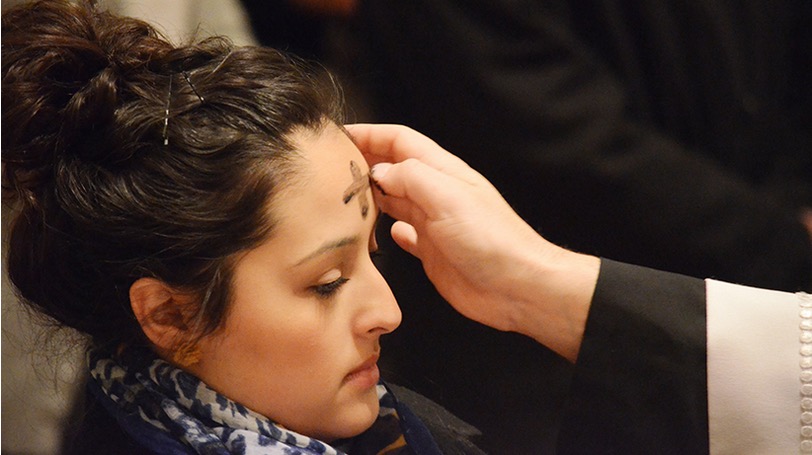Among the beautiful, meaningful and solemn ceremonies of the Catholic Church is the gathering of the faithful on Ash Wednesday.
This special day begins our Lenten journey. It is the start of 40 days of prayer, penance and almsgiving as we prepare ourselves to celebrate the resurrection of our Lord Jesus Christ on Easter Sunday. But why does Lent begin on a Wednesday, and what is the significance of ashes?
Ash Wednesday was added to the liturgical calendar well after the 40-day penitential season of Lent became the norm throughout the Latin Church. Lent, in turn, was universally established only after the early Church sorted out the date of Easter. The issue was clarified at the famous Council of Nicaea in 325 where “all the Churches agreed that Easter, the Christian Passover, should be celebrated on the Sunday following the first full moon (14 Nisan) after the vernal equinox” (Catechism of the Catholic Church, No. 1170). The vernal (spring) equinox generally falls on March 21, thus the date of Easter in the Western Church can occur anytime between March 22 and April 25.
Lent in the Early Church
The word Lent is from an Old English term meaning springtime, and by the second century the term was being used to describe the period of individual fasting, almsgiving and prayer in preparation for Easter. Among the Christians of the first three centuries, only those aspiring for baptism — the catechumens — observed a defined period of preparation, and that time lasted only two or three days. The idea of Lent being 40 days in length evolved over the next few centuries, and it is difficult to establish the precise time as to when it began. Among the canons issued by the Council of Nicaea, the Church leaders, in Canon Five, made reference to Lent: “and let these synods be held, the one before Lent that the pure gift may be offered to God after all bitterness has been put away, and let the second be held about autumn.” The language of this canon seems to validate that Lent, in some fashion, had by the fourth century been established and accepted by the Church. While the exact timing and extent of Lent both before and after the Nicaea council is unclear, what is clear from historical documents is that Christians did celebrate a season of Lent to prepare themselves for Resurrection Sunday and used a variety of ways to do so.
That Lent evolved into a period of 40 days in length is not surprising as there are numerous biblical events that also involved 40 days. Moses was on Mount Sinai receiving instructions from God for that number of days (see Ex 24:18); Noah and his entourage were on the Ark waiting for the rains to end for 40 days and 40 nights (Gn 7:4); and Elijah “walked forty days and forty nights to the mountain of God, Horeb” (1 Kgs 19:8). Mostly, though, the 40 days of Lent identifies with the time our Lord Jesus spent in the desert fasting, praying and being tempted by the devil (Mt 4:1-11). “By the solemn forty days of Lent the Church unites herself each year to the mystery of Jesus in the desert” (Catechism, No. 540).
There is, therefore, evidence that by the end of the fourth century Christians were participating in a 40-day Lent before Easter. The dilemma now became how to count the 40 days. In the Latin Church, six weeks were used to identify the Lenten period, but you didn’t fast on Sundays, so six Sundays were subtracted and there remained only 36 fasting days. In the early seventh century, St. Pope Gregory I the Great (r. 590-604) resolved this situation by adding as fast days the Wednesday, Thursday, Friday and Saturday before the first Sunday of Lent. Thus the Lenten 40-day fast, or the Great Fast as it was known, would begin on a Wednesday.
Initially, people fasted all 40 days of Lent. They ate one meal a day and only an amount of food that would sustain survival. But the Church taught, and people believed (then as now), that fasting is not about what we eat, it is about changing hearts, interior conversion, reconciliation with God and others. It’s about living in an austere way, giving from our abundance to the poor. St. John Chrysostom (347-409) explained it this way: “Do you fast? Give me proof of it by your works!… If you see a poor man, take pity on him! If you see an enemy, be reconciled to him! If you see a friend gaining honour, envy him not! If you see a handsome woman, pass her by!” (Homily on the Statutes, III.11).
Ashes
The Church has long used ashes as an outward sign of grief, a mark of humility, mourning, penance and morality. The Old Testament is filled with stories describing the use of ashes in such a manner. In the Book of Job, Job repented before God: “Therefore, I disown what I have said, and repent in dust and ashes” (42:6). Daniel “turned to the Lord God, to seek help, in prayer and petition, with fasting, sackcloth, and ashes” (Dn 9:3). Jonah preached conversion and repentance to the people of Nineveh: “When the news reached the king of Nineveh, he rose from his throne, laid aside his robe, covered himself with sackcloth, and sat in the ashes” (Jon 3:6). And the Maccabees army prepared for battle: “That day they fasted and wore sackcloth; they sprinkled ashes on their heads and tore their garments” (1 Mc 3:47).

Ashes were imposed on the early catechumens when they began their preparation time for baptism. Confessed sinners of that era were also marked with ashes as part of the public penitential process. Other baptized Christians began asking to receive ashes in a manner similar to catechumens and penitents. Christian men had ashes sprinkled on their heads while ashes were used to trace the cross on the forehead of women. Thus the use of ashes as the sign of penance, in readiness for Easter, was becoming a Churchwide practice. During the papacy of St. Gregory the Great, the practice was further expanded and is mentioned in the sixth-century Gregorian Sacramentary. Around the year 1000, Abbot Aelfric of the monastery of Eynsham, England, wrote: “We read in the books both in the Old Law and in the new that men who repented of their sins bestowed on themselves with ashes and clothed their bodies with sackcloth. Now let us do this little at the beginning of our Lent, that we strew ashes upon our heads, to signify that we ought to repent of our sins during the Lenten feast” (“Aelfric’s Lives of Saints,” 1881, p. 263). This same rite of distributing ashes on the Wednesday that begins Lent was recommended for universal use by Pope Urban II at the Synod of Benevento in 1091.
So when we go to that early Mass on Ash Wednesday morning and receive the blessed ashes on our forehead, we are repeating a somber, pious act that Catholics have been undergoing for over 1,500 years. As “The Liturgical Year, Septuagesima,” by Abbot Gueranger, O.S.B., written in the middle decades of the 1800s, puts it: “We are entering, today, upon a long campaign of the warfare spoke of by the apostles: forty days of battle, forty days of penance. We shall not turn cowards, if our souls can but be impressed with the conviction that the battle and the penance must be gone through. Let us listen to the eloquence of the solemn rite which opens our Lent. Let us go whither our mother leads us, that is, to the scene of the fall.”
Like all those before us, we unhesitatingly embrace this invitation to sanctity, this time to turn away from sin. We are part of that great cloud of witnesses who through all the ages have donned the ashes, publicly acknowledging that we are Christians, Christians who have sinned and seek to repent. We acknowledge that “we are dust and to dust we shall return.”
D.D. Emmons writes from Pennsylvania.

